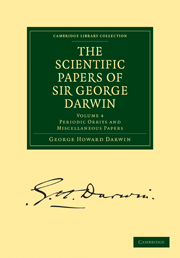Book contents
- Frontmatter
- PREFACE
- Contents
- Chronological List of Papers with References to the Volumes in which they are contained
- Errata
- PART I PERIODIC ORBITS
- PART II THE TIDES
- PART III MISCELLANEOUS PAPERS IN CHRONOLOGICAL ORDER
- 5 On some Proposed Forms of Slide-rule
- 6 An Application of Peaucellier's Cell
- 7 The Mechanical Description of Equipotential Lines
- 8 On a Mechanical Representation of the Second Elliptic Integral
- 9 On Maps of the World
- 10 A Geometrical Puzzle
- 11 A Geometrical Illustration of the Potential of a Distant Centre of Force
- 12 On Graphical Interpolation and Integration
- 13 On a Theorem in Spherical Harmonic Analysis
- 14 On Fallible Measures of Variable Quantities, and on the Treatment of Meteorological Observations
- 15 On the Horizontal Thrust of a Mass of Sand
- 16 On the Formation of Ripple-mark in Sand
- 17 Note on Mr Davison's Paper on the Straining of the Earth's Crust in Cooling
- 18 On the Mechanical Conditions of a Swarm of Meteorites, and on Theories of Cosmogony
- 19 On the Perturbation of a Comet in the Neighbourhood of a Planet
- 20 The Eulerian Nutation of the Earth's Axis
- 21 The Analogy between Lesage's Theory of Gravitation and the Repulsion of Light
- PART IV PAPERS ON TIDES (Supplementary to Volume I)
- PART V ADDRESSES TO SOCIETIES
- APPENDIX
- INDEX
- Plate section
7 - The Mechanical Description of Equipotential Lines
Published online by Cambridge University Press: 07 September 2010
- Frontmatter
- PREFACE
- Contents
- Chronological List of Papers with References to the Volumes in which they are contained
- Errata
- PART I PERIODIC ORBITS
- PART II THE TIDES
- PART III MISCELLANEOUS PAPERS IN CHRONOLOGICAL ORDER
- 5 On some Proposed Forms of Slide-rule
- 6 An Application of Peaucellier's Cell
- 7 The Mechanical Description of Equipotential Lines
- 8 On a Mechanical Representation of the Second Elliptic Integral
- 9 On Maps of the World
- 10 A Geometrical Puzzle
- 11 A Geometrical Illustration of the Potential of a Distant Centre of Force
- 12 On Graphical Interpolation and Integration
- 13 On a Theorem in Spherical Harmonic Analysis
- 14 On Fallible Measures of Variable Quantities, and on the Treatment of Meteorological Observations
- 15 On the Horizontal Thrust of a Mass of Sand
- 16 On the Formation of Ripple-mark in Sand
- 17 Note on Mr Davison's Paper on the Straining of the Earth's Crust in Cooling
- 18 On the Mechanical Conditions of a Swarm of Meteorites, and on Theories of Cosmogony
- 19 On the Perturbation of a Comet in the Neighbourhood of a Planet
- 20 The Eulerian Nutation of the Earth's Axis
- 21 The Analogy between Lesage's Theory of Gravitation and the Repulsion of Light
- PART IV PAPERS ON TIDES (Supplementary to Volume I)
- PART V ADDRESSES TO SOCIETIES
- APPENDIX
- INDEX
- Plate section
Summary
Fig. 1 represents two Peaucellier's cells, of which O1, O2 are the respective fulcra, which are fixed; A, P and B, P the poles. Let the moduli of the cells be respectively proportional to two charges of positive electricity at O1 and O2. Thus O1A = m1/O1P, O2B = m2/O2P, so that, if O1A + O2B is constant, P traces the equipotential line of m1 and m2 placed at O1 and O2 respectively. The constancy of O1A + O2B may be attained thus: Let the pivots at O1, O2, about which the cells turn, be two needles; fasten a piece of pack-thread to A, pass it round O1, round another needle E (driven into the drawing-board), round O2, and fasten the other end to B. The broken line in Fig. 1 represents this thread. Then, if P is moved so as to keep the thread taut, it describes one of the equipotential lines. If the needle E is shifted to F and G, we get other equipotential lines.
Fig. 2 represents the arrangement of the thread where one of the charges is negative. In this and the succeeding figures, fixed points are marked with crosses, and the needles are exaggerated so as to show the disposition of the strings, and the bars of the cells are omitted, leaving only the tracing point P and the other poles marked.
- Type
- Chapter
- Information
- The Scientific Papers of Sir George DarwinPeriodic Orbits and Miscellaneous Papers, pp. 269 - 271Publisher: Cambridge University PressPrint publication year: 2009First published in: 1911

